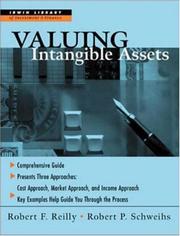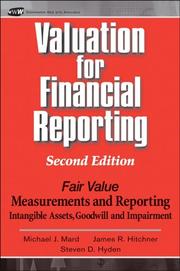| Listing 1 - 10 of 575 | << page >> |
Sort by
|

ISBN: 0786310650 Year: 1998 Publisher: New York : McGraw-Hill,
Abstract | Keywords | Export | Availability | Bookmark
 Loading...
Loading...Choose an application
- Reference Manager
- EndNote
- RefWorks (Direct export to RefWorks)

ISBN: 1282284843 9786612284847 0080515274 0121384101 9780121384104 9780080515274 9781282284845 Year: 1999 Publisher: San Diego : Academic Press,
Abstract | Keywords | Export | Availability | Bookmark
 Loading...
Loading...Choose an application
- Reference Manager
- EndNote
- RefWorks (Direct export to RefWorks)
Intellectual property law is currently exploding, as demonstrated by the growth of technology transfer offices in universities. More and more scientists, companies, and institutions are rushing to secure intellectual property rights for their ideas and inventions. This process frustrates many people; patent laws are constantly changing, and most books about them are either overly technical or boring. Protecting Your Ideas: The Inventor's Guide to Patents is a succinct, straightforward guide to the system. This guide presents the steps involved in obtaining patent protection for
Book
ISBN: 0471530387 Year: 1991 Publisher: New York (N.Y.) : Wiley,
Abstract | Keywords | Export | Availability | Bookmark
 Loading...
Loading...Choose an application
- Reference Manager
- EndNote
- RefWorks (Direct export to RefWorks)
Corporations --- Intangible property. --- Investments. --- Valuation.

ISBN: 9780471680413 Year: 2007 Publisher: Hoboken, N.J. : John Wiley,
Abstract | Keywords | Export | Availability | Bookmark
 Loading...
Loading...Choose an application
- Reference Manager
- EndNote
- RefWorks (Direct export to RefWorks)
Essential procedures for the measurement and reporting of fair value in Financial statements Trusted specialists Michael Mard, James Hitchner, and Steven Hyden present reliable and thorough guidelines, case studies, implementation aids, and sample reports for managers, auditors, and valuators who must comply with the Financial Accounting Standards Board Statement of Financial Accounting Standards Nos. 141, Business Combinations; 142, Goodwill and Other Intangible Assets; 144, Accounting for the Impairment or Disposal of Long-Lived Assets; and the new 157, Fair Value Measurements. This important guide: Explains the new valuation aspects now required by SFAS No. 157 Presents the new definition of fair value and certain empirical research Distinguishes fair value from fair market value Provides a case study that measures the fair values of intangible assets and goodwill under SFAS Nos. 141 and 157 Includes a detailed case study that tests the impairment of goodwill and long-lived assets and measures the financial impact of such impairment under SFAS Nos. 142 and 144 Cross-references and reconciles the valuation industry's reporting standards among all of the valuation organizations Includes two sample valuation reports, one of which is a new USPAP- compliant PowerPoint ; presentation format Includes implementation aids for controlling the gathering of data necessary for analyses and for guiding the valuation work program
Book
Year: 1962 Publisher: Berlin, : Duncker & Humblot,
Abstract | Keywords | Export | Availability | Bookmark
 Loading...
Loading...Choose an application
- Reference Manager
- EndNote
- RefWorks (Direct export to RefWorks)
Financial statements --- Intangible property --- Accounting.

ISBN: 0198765207 Year: 1999 Publisher: Oxford : Clarendon press,
Abstract | Keywords | Export | Availability | Bookmark
 Loading...
Loading...Choose an application
- Reference Manager
- EndNote
- RefWorks (Direct export to RefWorks)
Chemistry --- Patents. --- Patents --- Industrial property --- Intangible property

ISBN: 0126635536 9786611008383 1281008389 0080478549 1423722701 9781423722700 9780126635539 9780080478548 9781281008381 6611008381 Year: 2005 Publisher: Boston : Elsevier Academic Press,
Abstract | Keywords | Export | Availability | Bookmark
 Loading...
Loading...Choose an application
- Reference Manager
- EndNote
- RefWorks (Direct export to RefWorks)
This book asserts that intangibles create financial transactions, not vice versa. It offers distinct, reproducible methods of valuing intangibles in intangible forms, with associated and meaningful financial values. It also presents new management frameworks in which all forms of intangibles can be classified, measured, managed, and reported.*A practical, hands-on guide to a new approach to valuing intangibles*Progresses from simple to complex, using case studies that begin with short simple cases and progress to comprehensive real-life case studies*Highlights the distinction
Accounting. --- Intangible property. --- Intangible property - Accounting. --- Intangible property - Accounting - Standards. --- Intangible property - Valuation. --- Intangible property--Accounting. --- Intellectual capital. --- Intellectual capital - Management. --- Intellectual capital--Management. --- Knowledge management. --- Management. --- Standards. --- Valuation. --- Intellectual capital --- Intangible property --- Knowledge management --- Management --- Business & Economics --- Management Styles & Communication --- Accounting --- Standards --- Valuation --- Management of knowledge assets --- Incorporeal property --- Intangible assets --- Intangibles --- Law and legislation --- Information technology --- Organizational learning --- Property
Book
ISBN: 1282500252 9786612500251 9264079203 926407290X Year: 2010 Publisher: Paris : OECD,
Abstract | Keywords | Export | Availability | Bookmark
 Loading...
Loading...Choose an application
- Reference Manager
- EndNote
- RefWorks (Direct export to RefWorks)
The latest System of National Accounts (the 2008 SNA) explicitly recognises, for the first time, that expenditures on research and experimental development (R&D) should be recorded as capital formation. This is a natural extension to the 1993 SNA, which recommends recording many acquisitions of software and databases, mineral exploration, and entertainment, artistic and literary originals as capital formation, too. These products have a common characteristic, namely that their value reflects the underlying intellectual property they embody, which is why they are referred to collectively in this publication as intellectual property products (IPPs). But they also share another important characteristic: their measurement is not straightforward, and in the absence of clear guidance it is highly likely that estimates will not be comparable between countries. This Handbook is designed to provide that guidance by considering IPPs collectively, based on their common characteristics, by type, based on any specificities, such as data availability, and by detailed transaction - for example the valuation of IPPs that have been produced for internal use by their developers, the valuation of unsuccessful IPPs, and the production of IPPs produced and made freely available by government.
BUSINESS & ECONOMICS --- General --- Intellectual property --- Management Styles & Communication --- Management --- Business & Economics --- Economic aspects --- Intangible property. --- Economic aspects. --- Incorporeal property --- Intangible assets --- Intangible property --- Intangibles --- Law and legislation --- Property

ISBN: 1841161098 Year: 2002 Publisher: Henley on Thames : World advertising research center,
Abstract | Keywords | Export | Availability | Bookmark
 Loading...
Loading...Choose an application
- Reference Manager
- EndNote
- RefWorks (Direct export to RefWorks)
Advertising --- Brand loyalty. --- Brand name products --- Intangible property --- Research. --- Valuation.

ISBN: 033396019X Year: 2001 Publisher: Houndmills : Palgrave,
Abstract | Keywords | Export | Availability | Bookmark
 Loading...
Loading...Choose an application
- Reference Manager
- EndNote
- RefWorks (Direct export to RefWorks)
Competition --- Intangible property --- Knowledge management --- Technological innovations --- Management --- Management.
| Listing 1 - 10 of 575 | << page >> |
Sort by
|

 Search
Search Feedback
Feedback About UniCat
About UniCat  Help
Help News
News